A rugged coastline surrounds a mountainous interior resulting in endless views. A small population on this large cape means that there is a lot of wilderness to discover. Connected to mainland Nova Scotia by a 1.3 km causeway, Cape Breton Island feels very remote.

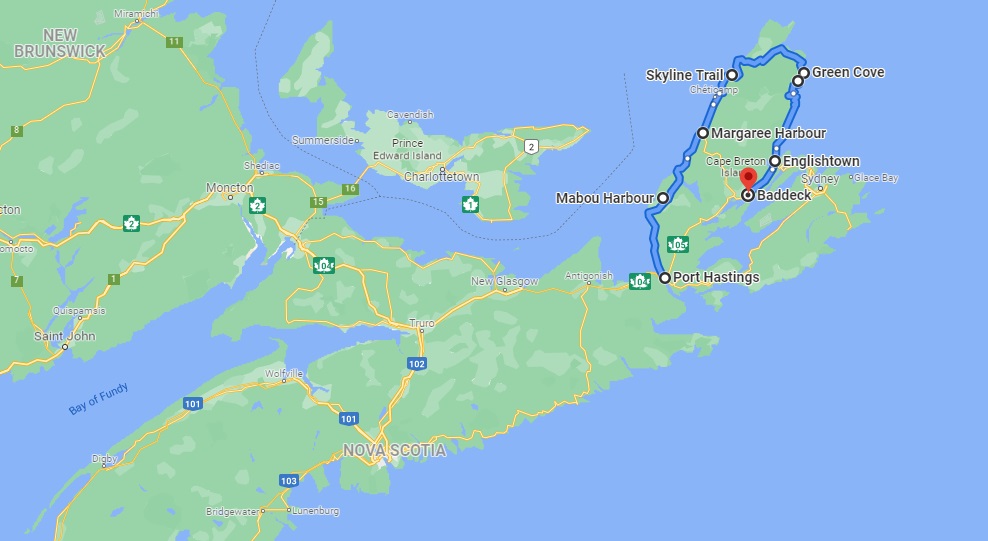
Since it’s such a large island with a lot to see, we are recommending a few of our favourite spots for your next trip to Cape Breton.
Nova Scotia’s Scottish Heritage is visible in many places in the province, but nowhere is it more obvious than Cape Breton. The first highway you’ll take after passing over Canso Causeway is called Cellidh Trail (Hwy #19). The Gaelic word translates in English to ‘party’ or ‘social gathering’, which feels like a welcoming name for a road. Ceilidh Trail offers amazing views of the Gulf of St. Lawrence as it passes large sandy beaches, small towns and cute fishing villages. The first stop we suggest is Mabou Beach. A lovely sandy beach is spread out in front of a calm bay. Just before the beach is a small fishing harbour with a lighthouse.
The town of Inverness is another clue to their Scottish heritage. The popular golf course in this cute town has spectacular views of the Gulf of St. Lawrence.
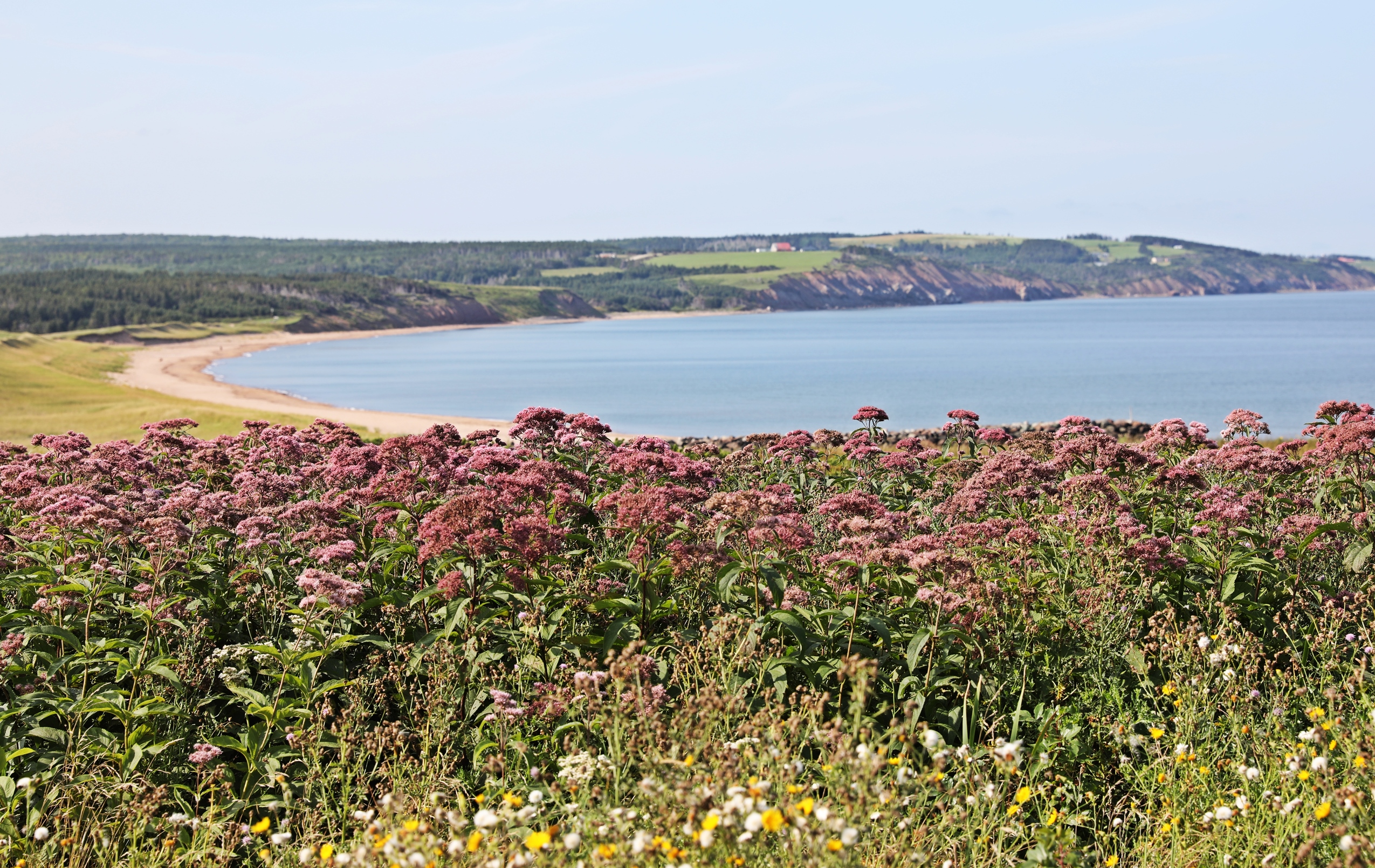
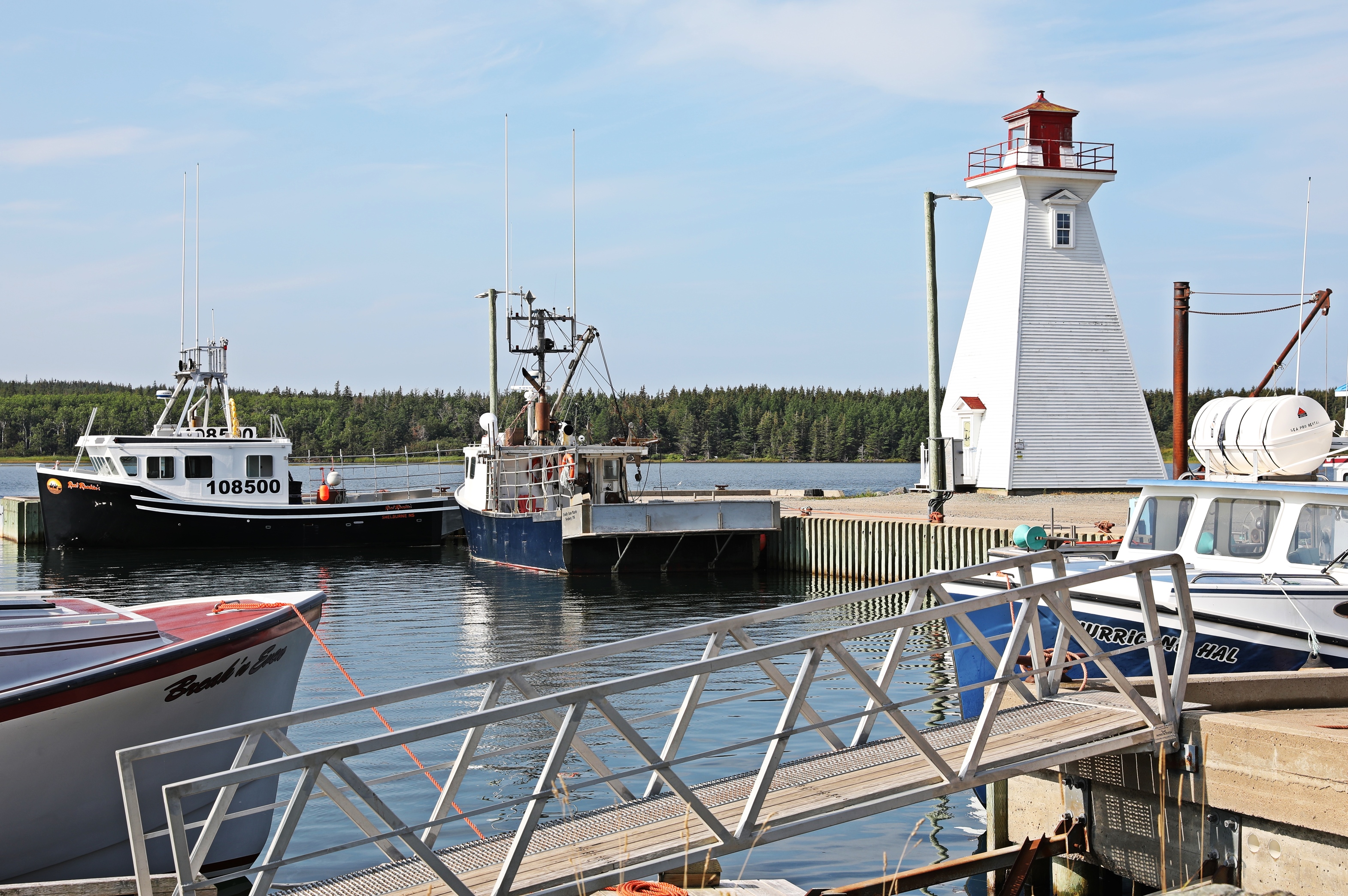



One of the cutest views on Cellidh Trail is Margaree Harbour. The town’s placement at the mouth of the Margaree River as it enter the Gulf of St. Lawrence makes it very scenic.

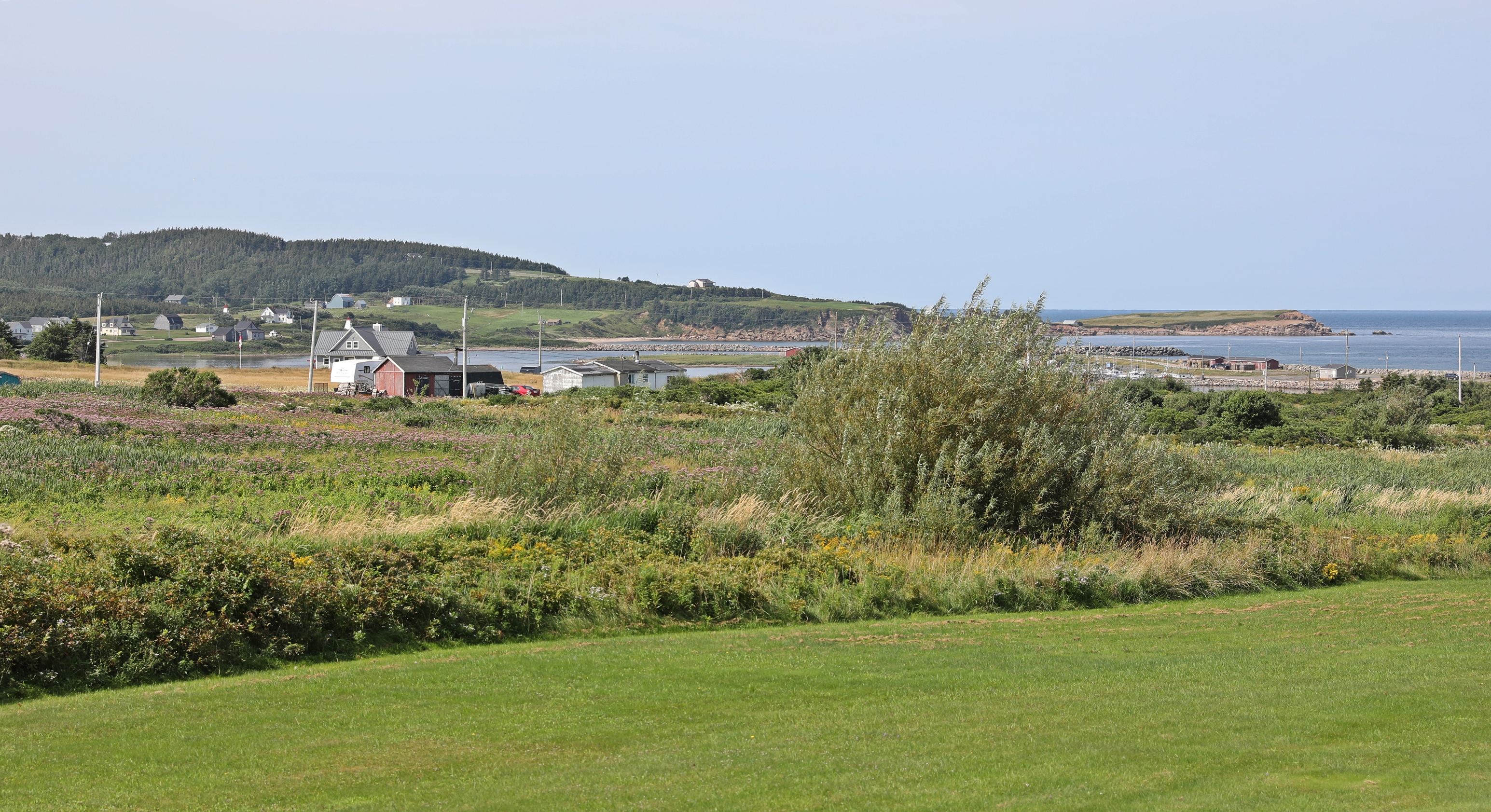
North of Margaree, Cellidh Trail becomes Cabot Trail. The 298 km long Cabot Trail is named after Italian explorer Giovanni Caboto. His name was anglicized to John Cabot. He arrived on Canada’s shores in 1497, sailing on a mission for King Henry VII of England.
The road has a lot of steep climbs, descents and sharp corners as it follows the outline of the coast. The further north you drive on this famous roadway, the cliffs get larger and larger until it enters Cape Breton Highlands National Park.

There are 26 hiking trail inside the park. Most are short, day hikes. One of the most popular is Skyline Trail. This easy 6 ½ km trail can be done as an out and back or as a loop if you add another 1 ½ kms. We hiked the loop in a CCW direction. Most people take the left branch of the trail so they can walk directly to the lookout. Taking the right branch meant we missed most of the crowd on the way up. Both directions spend the first 3 or 4 km in the trees, although the CCW loop brings you to more open areas.
Once you arrive at the lookout, a long wooden staircase that takes you down the hill to better and better views of the long coastline and the Cabot Trail. It was a nice view, but not as spectacular as some we have already seen.


As you drive through the park you’ll pass 24 viewpoints. A few require short hikes, but others are along the side of Cabot Trail. After Skyline Trail, the first viewpoint you’ll reach is Fishing Cove. From the highway you look down to see a small cove, far below.
As its name suggests, there are a lot of mountains in the interior of Cape Breton Highlands National Park. You can get a nice view of these highlands from Pleasant Bay Viewpoint.


From here, Cabot Trail cuts across the mountainous interior to reach the coast on the eastern side. The drive takes you through pine forests, offering few views. Once at the coast though, the views are lovely. Plan to stop for a short, 2 km, hike on Jack Pine Trail. The hike meanders through a Jack Pine forest until it reaches a gorgeous rocky inlet. We walked out onto the granite rocks of this tight inlet watching the Atlantic Ocean crash up to their sides. It is one of the prettiest spots we found in the park.
The next few stops come one right after the other but offer slightly different views of the rough coast. A short hike brought us to the pretty MacKinnons Cove. Shortly after we reached Green Cove where we could walk out on to the rocks to the edge of the rough water. Our final stop in this stretch was Lakies Head where we could see all the way down the coast to see Stanley Point in the distance.

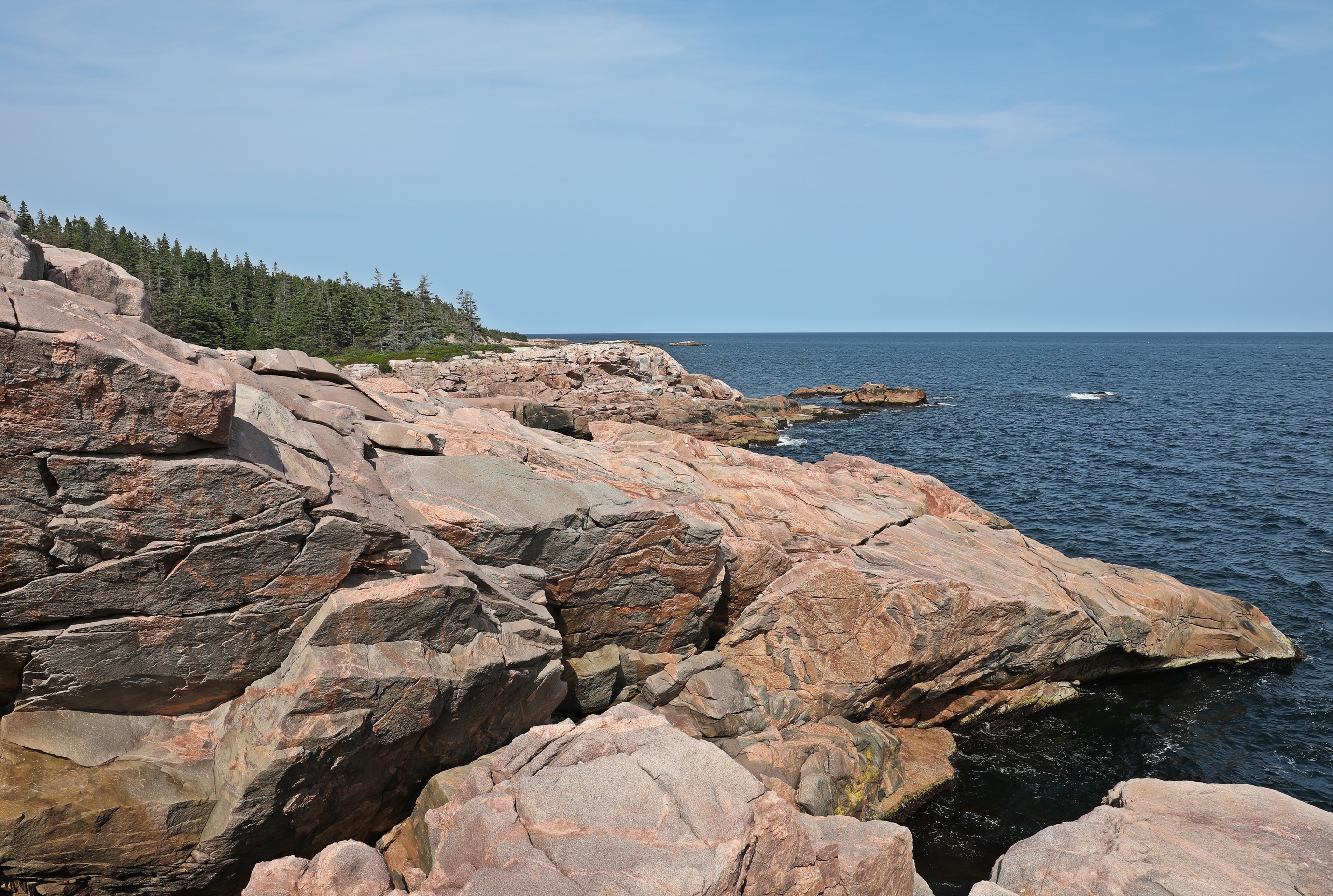



Many places in Nova Scotia reveal their connection to the Mi’kmaw people. Towns such as Ingonish, Tatamagouche and Antigonish are examples of this. Just inside the park gates you’ll find the cute beach town of Ingonish. Sheltered in South Bay, Ingonish Beach is a popular summer spot.

Outside of the park, we had one of the best views on the entire Cabot Trail. From the top of Cape Smokey, the undulating south coast appeared to go on forever beside forested green hills. It is a breathtaking view. From this spot we had a long drive down. The road here has a 13 percent gradient, one of the steepest descents we’ve ever had.

After leaving the highlands we wanted to visit the scenic area around Bras D’Or Lakes. To reach this area from Cape Breton Highlands National Park, you can follow the inland trail, or do as we did and take a small ferry at Englishtown. Since we enjoyed the small LaHavre Cable Ferry a few days earlier we knew we wanted to ride on another. The free ferry holds 14 cars so there may be a wait but it’s still faster and more interesting than driving on the inland highway. It’s a short ride at only 3 minutes to go 150 m to the other side. The ferry is open 24/7 during high season and there are signs on the road letting you know if it’s open or closed.
Bras D’Or Lakes is a large estuary that takes up much of Cape Breton’s interior. On the edge of one of the lakes is the cute village of Baddeck. There are a few short hikes in the area and a lot of options for boating in the estuary.



Tips for visiting Cape Breton
You can drive through Cape Breton Highlands National Park for free, but if you plan to stop, which you most likely will, there is a fee. You can purchase a day pass or use your Annual Discovery Pass at the park gates.
We drove around the island and the park in a clockwise direction, so that’s how we’ll describe it. Either direction would allow you to see these sites, and I don’t think either direction makes it better than the other.
Although the views were lovely, Cape Breton wasn’t as spectacular as we had hoped. Sometimes having low expectations is good when traveling.
Where to stay on Cape Breton
There are many small towns on the island with bed and breakfasts, small hotels and campgrounds. Popular places to stay include Inverness, Ingonish, Baddeck or of the many campgrounds in the park.
Coming Next – Louisbourg – Canada’s Atlantic Fort
For more pictures from our travels around the world visit Gallery on monkeystale.ca
To read stories from Canada click here; from other parts of the world visit Destinations.
If you like what you read please share, with credit, using one of the links below.
These are picture-postcard perfect views. Thanks for sharing them.
LikeLiked by 1 person
Thank you! Cape Breton has some beautiful spots. Maggie
LikeLike
Beautiful photos, descriptive and detailed descriptions, your journeys take me right where you go. A blessing and a gift. Thank you.
LikeLiked by 1 person
Thank you Suzette, glad you cane along 😊 Maggie
LikeLiked by 1 person
That Cabot Trail sounds like just the sort of road we love to drive! Or at least, that I love – my husband, the driver, might be slightly less enthusiastic 😆 But at least there are plenty of places to stop and enjoy those wonderful views!
LikeLiked by 1 person
It is better for the passenger, but actually with a car it’s not bad driving. I’ve heard that it’s a little scary with a big RV. There are a lot of pull outs to enjoy the view. Thanks for reading Sarah! Maggie
LikeLiked by 1 person
We have driven this route many times over the years and it seldom disappoints. The last time, we went counter clockwise for the first time. I think this direction is more scenic. Hope they can repair the flood damage to the trail. Thanks for sharing your travels through this spectacular part of Canada. Allan
LikeLiked by 1 person
Yes it sounds like a lot of damage near Ingonish. Also a lot in Newfoundland. I think if we went CW we may have missed our favourite view from Cape Smokie. Thanks for reading Allan, Maggie
LikeLiked by 1 person
There is actually a pull off at Cape Smoky where we stopped for the view (partly foggy) and then we stayed the night at Ingonish Beach with fabulous views in both directions. We know dear people in Port Hawkesbury and went to Isle Madame for the wedding of our neighbour’s daughter in 2016. The Acadian area is so pretty too. So much to see. A
LikeLiked by 1 person
Yes, we stopped at the same pullout. A wedding on Isle Madame would have been lovely. My best friend from highschool has a cabin just on the other side of the causeway from Port Hawkesbury where we stayed. It was a gorgeous spot! Have a Merry Christmas Allan! Maggie
LikeLiked by 1 person
So many hikes? This is surely a big draw for me especially when there are some that offer a view of the bay!
LikeLiked by 1 person
Yes it’s really great. Most of them are quite short, 1-2 km, but it’s nice to get out of the car to see the views. And there are so many hikes that there are never many at on hike. You’d love taking pictures on Cape Breton! Maggie
LikeLiked by 1 person
Well, when you mention hikes, you got all my attention, Maggie. 🙂
LikeLiked by 1 person
😊
LikeLiked by 1 person
Looks such a beautiful area so perfect for hiking trails. Looks like you copped some good weather too.
LikeLiked by 1 person
We were really lucky with the weather that day. The next day it poured almost all day. It would have been awful to do the drive without views. Have fun in the sun! Maggie
LikeLiked by 1 person
Very Scottish in appearance, some of it. Reminds me of Dumfries and Galloway. I love a rolling hill and a coastal view. Add in a ferry and I’m sold! I suspect it’s a cold, bleak place in winter though? Wishing you both a merry Christmas and good health and happiness in ’22.
LikeLiked by 1 person
You’d love Cape Breton then! They are very proud of their Scottish ancestry, but have added their own Maritime twist. Thanksnfor reading Jo. Merry Christmas to you Maggie
LikeLike
Seems like you have a never-ending vacation: lucky you!
LikeLiked by 1 person
It was pretty long. One more province to go! Merry Christmas Bill. Maggie
LikeLiked by 1 person
Season’s Greetings and Happy New Year to you! Newfoundland?
LikeLiked by 1 person
So incredibly scenic. Great post!
LikeLiked by 1 person
Thanks! It is a scenic drive. Merry Christmas to you two 🙂 Maggie
LikeLike
You just got me wanting to see a national park again!
LikeLiked by 1 person
🙂 Hope you get to soon!
LikeLiked by 1 person
I like the contrast of those rocky outcrops with the lush pine forest above them. I agree with you about managing our expectations when visiting a new place. I always try not to get too excited about a destination until I get there.
LikeLiked by 1 person
I also usually try not to get too excited when traveling, but in Canada we hear about how incredible Cabot Trail is for most of our lives. It is beautiful, I was just expecting too much. Thanks for reading Bama! Maggie
LikeLiked by 1 person
Perhaps because it was so long ago that I visited Cape Breton, I remember it as one of the most beautiful drives we’d ever done. One weird thing I remember is trying snow crab legs for the first time (in Ingonish) and thinking they were the best thing I’ve ever tasted.
LikeLiked by 1 person
It is a beautiful drive, but I think we’d heard so much about its beauty and expected too much. We actually liked the views once we were off Cabot Trail more than from it. Maybe we’re just spoiled. Hope you and Mike have a Merry Christmas! Maggie and Richard
LikeLiked by 1 person
Merry Christmas to you, Maggie and Richard! Stay warm during the upcoming cold snap.
LikeLiked by 1 person
Such a wonderful collection of beautiful photos, Maggie. I’ve heard about Cabot Trail where you can enjoy spectacular coastal views from the panoramic roadside look-offs, pristine beaches, maintained hiking trails, and warm Celtic and Acadian hospitality and I always wanted to visit. Skyline Trail in Cape Breton Highlands National Park is one place I wanted to visit the most! Thanks for sharing and have a good day 🙂 Aiva
LikeLiked by 2 people
Thanks Aiva, it is a beautiful place, but don’t be like me and expect too much. The hospitality though, definitely lives up to its reputation. Have a Merry Christmas! Maggie
LikeLike
The scenery in Cape Breton looks stunning. The Cabot Trail looks like such a lovely drive with fantastic views of the coastline and surrounding area. 24 viewpoints is a lot, but it’s a nice way to break up the drive and stretch the legs.
LikeLiked by 2 people
We stopped at many of the viewpoints and it was nice to break up the drive. Some of the views were spectacular, and we definitely showed pictures from the best ones. There were a lot of viewpoints though and not all are necessary. Are you planning on going to Cape Breton?
LikeLiked by 1 person
You bet!! It seems like it’s worth the drive to get to!!
LikeLiked by 1 person
It is, it’s very pretty but go with lower expectations. We had too high of expectations for it and weren’t blown away.
LikeLiked by 1 person
I have never been to Cape Breton but Pierre has in his youth. It looks lovely…
LikeLiked by 1 person
And you’re so close! At least compared to us. It is lovely with a few amazing views. Thanks for reading! Maggie
LikeLike
Your photos are stunning! The terrain is quite similar to Scotland. Thanks for sharing and happy holidays!
LikeLiked by 2 people
That’s probably why so many Scots ended up staying here, it reminded them of home. Happy Holidays! Maggie
LikeLiked by 1 person
The scenery looks beautiful. I love the combination of the ocean and the mountains.
LikeLiked by 1 person
Yes it’s a beautiful landscape on Cape Breton. Thanks! Maggie
LikeLiked by 1 person
Wow! You witnessed such spectacular sceneries.
LikeLike
Had never heard of this trail so it was a nice journey of discovery. Would be cool to see those Mi’kmaw influences, love those town names.
LikeLiked by 1 person
It’s very well known within Canada for its great coastal views. The little picturesque towns with unusual names are the best part. Thanks for reading Leighton. Merry Christmas! Maggie
LikeLiked by 1 person
Pretty coastal views. Some of the pictures resemble the north shore of Lake Superior in Minnesota.
LikeLike
Wonder whether you are heading to Newfoundland next and maybe even to l’Anse aux Meadows
LikeLiked by 2 people
Yes. We have one more in Nova Scotia then on to Nfld. L’Ase aux Meadow will probably be first. Have a wonderful Chritmsas Bill
LikeLike
I just write two posts on l’anse aux meadows. 😉
LikeLiked by 2 people
Yes I read them! 😊
LikeLike
Oh thank you
LikeLike
Your great photos of Cape Breton remind me of my time on the same spots on the Cabot Trail. I can’t help but point out Chéticamp, an Acadian village just before the national park where suddenly everything is in French.
LikeLiked by 1 person
Thanks, it s a great Canadian drive isn’t it 🙂 Maggie
LikeLiked by 1 person
One of the best and safest to recommend.
LikeLike
One of the best drives in Canada, thank you for reviving my fond memories of Cape Breton🙂
And also the place with the best lobster we’ve ever had!
LikeLiked by 1 person
That’s funny, Caroline said she had the best crab legs on Cabot Trail! I don’t eat it, so I’ll never know:) Maggie
LikeLiked by 1 person
Good to remember🙂 We have not had crab legs, but any other sea food was at its best!! Now, that I am thinking, our visit in NS was the time when I got in love with sea food. Not that I eat much, but I couldn’t really find any other better place🙂
LikeLiked by 1 person
Thank you for such a beautiful travelogue. I was in Nova Scotia and Cape Breton in 2009, but it seems a lifetime ago. Thanks for the great memories of a gorgeous place and wonderful, friendly people
LikeLiked by 1 person
McKinnon’s cove sure is beautiful. You are piquing my interest to see the place my great grandmother was born, in Nova Scotia.
LikeLiked by 1 person
You should visit. Nova Scotia has so many amazing places. Maggie
LikeLiked by 1 person
Thanks, Maggie. I think it would be a great summer trip for us. 🙂
LikeLike
It’s always fun to read a post about a place I’ve been. I enjoyed reminiscing about some of these locations and also learning about some new ones that we didn’t visit when we were there. Aside from the Canadian Rockies, this is my favorite place in Canada. Looks like you guys had a great time there!
LikeLiked by 1 person
It is a pretty drive, just wait until you see the views from Newfoundland, you may need to add it to another Canadian trip 😊
LikeLiked by 1 person
Oh, I already have a Newfoundland trip fully planned! No idea when we’ll be able to do it, but it’s planned. I can’t wait to see/read about your Newfoundland adventures.
LikeLike
Ah my childhood home, Cape Breton. I grew up in West Bay, on the Bra d’or lake. All familiar places.
LikeLiked by 1 person
Oh wow what a beautiful backyard!
LikeLike
It is. 😊
LikeLike
The winding up-and-down roads look a bit dizzying! My favorite photos here are of the Jack Pine hike and MacKinnons Cove; the views by the sea are beautiful.
LikeLiked by 1 person
Those were our favourite spots too. We could not get enough of the rugged inlets and rough ocean. Thanks for your comments Ruth! Maggie
LikeLiked by 1 person
I love the post! I just visited Cape Breton last summer and we stayed in Keltic Lodge!
LikeLiked by 1 person
Thanks Ariela! It us a great part of the country isn’t it?! Maggie
LikeLike
Such beautiful photos and views!
LikeLiked by 1 person
Thank you!
LikeLiked by 1 person